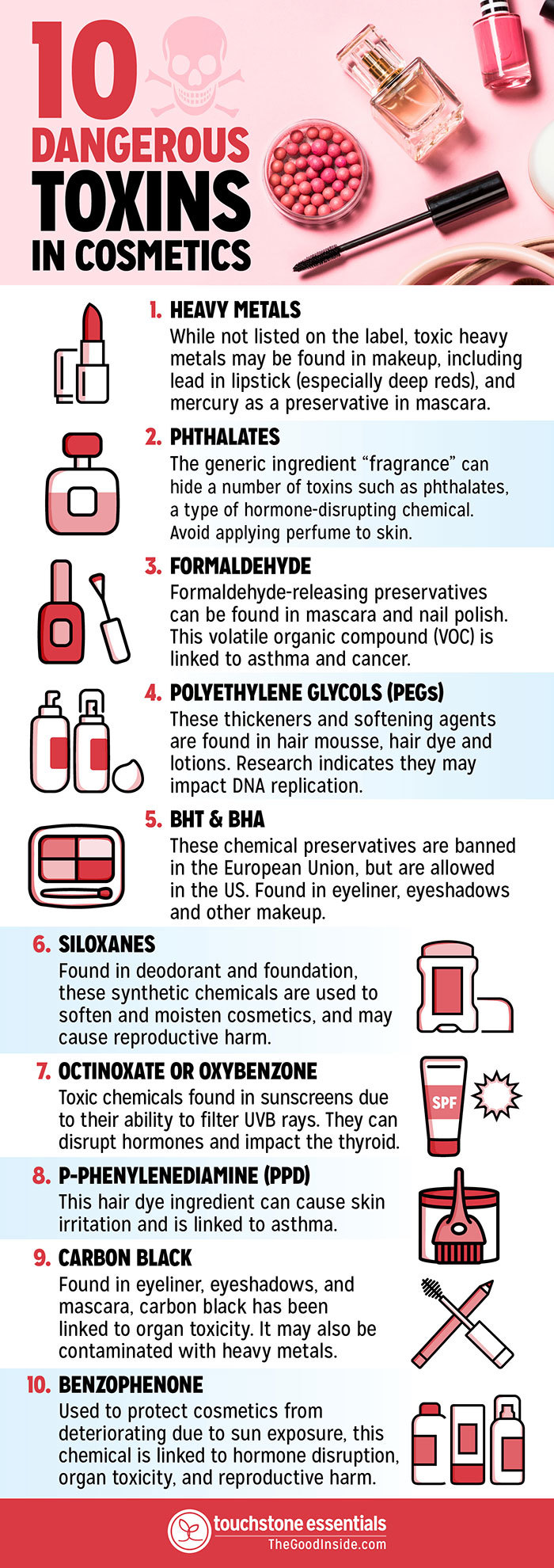10 Common Toxins in Cosmetics

Formulated to highlight features, accentuate the eyes, and lengthen lashes, cosmetics are designed to emphasize natural beauty. However, much of the makeup industry hides an ugly truth: those beauty products can be laced with toxins that undermine health.
The skin is the body’s largest organ, and while it acts as a physical barrier to keep us safe, it’s not an impenetrable shield. When you apply sunscreen, lotions, and makeup, ingredients readily pass through the skin and into the bloodstream. It’s an especially challenging issue since many women wear makeup and apply these types of products every day.
To help you navigate the unsafe world of cosmetics, check out the list of 10 of the most dangerous toxins commonly found in makeup. At the end, you’ll also see how to check your favorite products to make sure they’re safe.

1. Heavy Metals
Heavy metals can cause substantial damage and accumulate in your tissues. At higher doses, heavy metals can cause brain damage, cancer, and organ failure (1). At lower doses, they can contribute to inflammation, fatigue, and even cause your skin to age more quickly.
Many makeup products (including eye shadow, lipstick, and lip gloss) contain heavy metals like lead, cadmium, nickel, mercury, and chromium. A study conducted by Safe Cosmetics, for example, found that over 60% of lipsticks contain the toxic heavy metal lead (2).
2. Phthalates (Fragrance)
While a cosmetic company may label its ingredients, phthalates are often hiding under the vague description of “fragrance.” Found in perfume, lotions, or any product with added fragrance, phthalates are a type of hormone-disrupting chemical.
Numerous studies have linked phthalates to birth defects, breast cancer, a decreased IQ, obesity, autism, and neurological issues (3, 4, 5). Check labels and avoid applying perfume to skin.
3. Formaldehyde-Releasing Preservatives
Many beauty products contain formaldehyde-based preservatives which break down over time, releasing formaldehyde—a volatile organic compound (VOC) that’s known to cause cancer and asthma (6, 7). If your cosmetics have a label, keep an eye out for chemicals such as DMDM hydantoin, bromopol, sodium hydroxymethylglycinate, quaternium-15, and glyoxal. They’re most commonly in mascara and nail polish.
4. Polyethylene Glycols (PEGs)
Polyethylene glycols create the creamy texture we expect in many cosmetics as they are used as thickeners and softeners (8). For this reason, they are commonly found in hair mousse and lotions. These petroleum-based compounds may be contaminated with ethylene oxide and 1,4-dioxane which can harm the nervous system and interfere with human development (9).
5. BHT & BHA
While these two chemical preservatives are banned in the European Union, they are still commonly used in the US, found in cosmetics including eyeliner, eyeshadows and other makeup (10). Numerous studies have found that these two chemicals are linked to cancer, hormone disruption, organ damage, and reproductive harm (11, 12). Much like heavy metals, they can accumulate in the body, leading to greater harm over time.
6. Siloxanes
Siloxanes are chemicals often used in cosmetics to soften, smooth, and moisten. For this reason, they are often found in deodorant and foundation. They are also used in hair products to help them dry more quickly.
Depending on how they’re modified in the lab, there’s evidence that siloxanes can disrupt your hormones, cause reproductive harm, damage the immune system, and reduce fertility (13). If there’s an ingredients label, look out for anything that ends in siloxane or methicone.
7. Octinoxate or Oxybenzone
Octinoxate and Oxybenzone are chemicals commonly used to filter UVB light from the sun and are usually found in sunscreens. This chemical is rapidly absorbed through the skin. Evidence suggests that exposure can disrupt your hormones and cripple the function of your thyroid (14).
8. P-Phenylenediamine (PPD)
This chemical can cause allergic reactions on the skin and damage the DNA of your cells. Over time, cellular DNA damage can cause cells to mutate into cancer cells (15). Since p-phenylenediamine is a common hair dye ingredient, scientists have observed a correlation between hair dye and multiple forms of cancer like ovarian, breast, and bladder (16, 17, 18).
9. Carbon Black
This pigment is an ingredient used in many eyeliner, eyeshadow, and mascara products. Carbon black is made from the partial combustion of various carbon-containing materials. It gives eyeliner its flat black coloring. Exposure to this chemical is linked to cancer and organ toxicity (19). Pigments are also commonly contaminated with heavy metals such as lead.
10. Benzophenone
Commonly used to protect cosmetics from deteriorating due to sun exposure, this chemical is linked to hormone disruption, organ toxicity, and reproductive harm (20, 21).
Protecting Your Health
Given the vast quantity of ingredients used and huge range of cosmetic products on the market, it’s impossible to eliminate your exposure to every toxin. The good news is that awareness has grown about the issue of toxins in cosmetics, and there are resources you can use to reduce your exposure.
You can check the clean rating of your personal cosmetic products (or individual ingredients) on the EWG Skin Deep database. The Campaign for Safe Cosmetics is another valuable resource to avoid toxins in cosmetics.
Avoiding toxins is vital. But often, it’s not enough. If you’re like most people, you have already been using cosmetics for much of your life. Since many of the toxins found in cosmetics bioaccumulate, it’s important to detoxify or remove them from your body.
To support your body’s detoxification process, use natural mineral zeolite that has been cleansed and nanosized for cellular detox. A rare negatively-charged mineral, the zeolite Clinoptilolite binds to positively-charged toxins like a magnet, so toxins can be safely and gently flushed out of the body.

